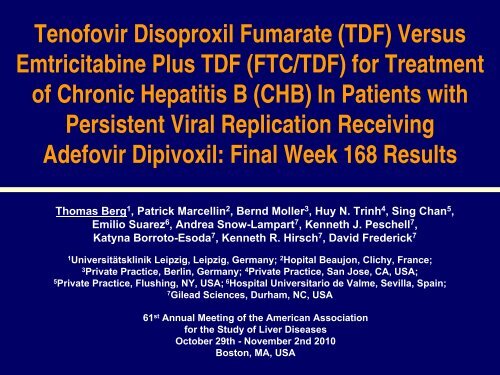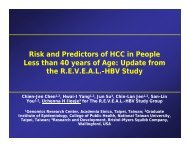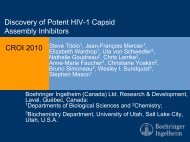Versus EmtricitabinePlus TDF - HIVandHepatitis.com
Versus EmtricitabinePlus TDF - HIVandHepatitis.com
Versus EmtricitabinePlus TDF - HIVandHepatitis.com
You also want an ePaper? Increase the reach of your titles
YUMPU automatically turns print PDFs into web optimized ePapers that Google loves.
Tenofovir Disoproxil Fumarate (<strong>TDF</strong>) <strong>Versus</strong><br />
Emtricitabine Plus <strong>TDF</strong> (FTC/<strong>TDF</strong>) for Treatment<br />
of Chronic Hepatitis B (CHB) In Patients with<br />
Persistent Viral Replication Receiving<br />
Adefovir Dipivoxil: Final Week 168 Results<br />
Thomas Berg 1 , Patrick Marcellin 2 , Bernd Moller 3 , Huy N. Trinh 4 , Sing Chan 5 ,<br />
Emilio Suarez 6 , Andrea Snow-Lampart 7 , Kenneth J. Peschell 7 ,<br />
Katyna Borroto-Esoda 7 , Kenneth R. Hirsch 7 , David Frederick 7<br />
1<br />
Universitätsklinik Leipzig, Leipzig, Germany; 2 Hopital Beaujon, Clichy, France;<br />
3<br />
Private Practice, Berlin, Germany; 4 Private Practice, San Jose, CA, USA;<br />
5<br />
Private Practice, Flushing, NY, USA; 6 Hospital Universitario de Valme, Sevilla, Spain;<br />
7<br />
Gilead Sciences, Durham, NC, USA<br />
61 st Annual Meeting of the American Association<br />
for the Study of Liver Diseases<br />
October 29th - November 2nd 2010<br />
Boston, MA, USA
Thomas Berg, MD<br />
I have financial relationships within the last 12 months relevant to my<br />
presentation with Bristol-Myers Squibb, Gilead Sciences, Human<br />
Genome Sciences, Merck, Roche, Schering Plough, Tibotec, Vertex<br />
AND<br />
My presentation does include discussion of off-label or investigational use<br />
FTC/<strong>TDF</strong> for the treatment of HBV
Introduction<br />
• Virologic suppression by adefovir dipivoxil (ADV) is<br />
in<strong>com</strong>plete in some cases, resulting in persistent viremia on<br />
treatment<br />
• Options include switching to a single more potent drug or to<br />
two drugs with different resistance pathways<br />
• The preferred treatment strategy in this heavily pretreated<br />
population remains to be defined and requires continued<br />
evaluation beyond 2 years
Study Objective<br />
• A <strong>com</strong>parison of the long-term safety and efficacy of two<br />
treatment strategies for ADV suboptimal responders, most<br />
with prior/current lamivudine (LAM) use:<br />
– Compare the antiviral efficacy (HBV DNA < 400 copies/mL) of<br />
• Monotherapy with <strong>TDF</strong> 300 mg QD (with option to add FTC<br />
200 mg)<br />
versus<br />
• Fixed-dose <strong>com</strong>bination of FTC 200 mg + <strong>TDF</strong> 300 mg QD<br />
The data were analyzed by Intent to treat (ITT): virologic failure = persistent HBV<br />
DNA ≥ 400 copies/mL (69 IU/mL), or a confirmed loss of response or<br />
discontinuation (non<strong>com</strong>pleter=failure (NC=F)).<br />
Subjects on open-label FTC/<strong>TDF</strong> will not be considered failures unless they meet<br />
the criteria described above.
Key Eligibility Criteria<br />
• 18–69 years of age<br />
• HBeAg positive or negative<br />
• Currently treated with ADV 10 mg QD (for ≥ 24<br />
weeks but ≤ 96 weeks), with persistent viremia (HBV<br />
DNA ≥ 172 IU/mL (1000 copies/mL) (Roche Cobas<br />
TaqMan Assay, lower limit of quantification 29 IU/mL<br />
[169 copies/mL])<br />
• Con<strong>com</strong>itant and past treatment with lamivudine<br />
permitted<br />
• ALT levels < 10 × the upper limit of normal (ULN)<br />
• Compensated liver disease; no evidence of HCC<br />
• No co-infection with HCV, HIV, or HDV
Study 106 Design<br />
RANDOMIZATION 1:1<br />
Double Blind<br />
Tenofovir<br />
300 mg<br />
FTC 200 mg /<br />
Tenofovir<br />
300 mg<br />
Week 24*<br />
Total Study Duration = 168 Weeks (Blinded or Open Label)<br />
Blinded<br />
<strong>TDF</strong> or<br />
OL<br />
FTC/<strong>TDF</strong><br />
Blinded<br />
FTC/<strong>TDF</strong><br />
or OL<br />
FTC/<strong>TDF</strong><br />
Blinded<br />
<strong>TDF</strong> or<br />
OL<br />
FTC/<strong>TDF</strong><br />
Blinded<br />
FTC/<strong>TDF</strong> or<br />
OL<br />
FTC/<strong>TDF</strong><br />
Week 48<br />
Analysis<br />
(Berg et. al., Gastro 2010)<br />
Week 96<br />
Analysis<br />
(EASL 2009)<br />
Blinded<br />
<strong>TDF</strong> or<br />
OL<br />
FTC/<strong>TDF</strong><br />
Blinded<br />
FTC/<strong>TDF</strong> or<br />
OL<br />
FTC/<strong>TDF</strong><br />
Week 168<br />
End of<br />
Study<br />
Final Study<br />
Results<br />
(AASLD 2010)<br />
*From WK24 on, patients with confirmed HBV DNA ≥ 69 IU/mL had the option to add FTC (as fixed<br />
dose FTC/<strong>TDF</strong>) or discontinue from the trial<br />
•<strong>TDF</strong> and FTC/<strong>TDF</strong> achieved viral suppression in 81% of patients at WK48 1 , and in 89% (<strong>TDF</strong>) and 83%<br />
(FTC/<strong>TDF</strong>) at WK96 2
Patient Disposition at 168 Weeks<br />
N=105<br />
Randomized and Treated<br />
N=53<br />
<strong>TDF</strong><br />
N=52<br />
FTC/<strong>TDF</strong><br />
Discontinued = 15 (7 <strong>TDF</strong>*, 8 FTC/<strong>TDF</strong>)<br />
Added FTC (OL fixed dose FTC/<strong>TDF</strong>) = 25<br />
•16 blinded <strong>TDF</strong> to OL FTC/<strong>TDF</strong><br />
•9 blinded FTC/<strong>TDF</strong> to OL FTC/<strong>TDF</strong><br />
N=46 (35 blinded, 11 OL)<br />
Completed Week 168<br />
N=44 (39 blinded, 5 OL)<br />
Completed Week 168<br />
*One patient discontinued study due to HBsAg loss.
Baseline Disease and<br />
Demographic Characteristics<br />
<strong>TDF</strong><br />
(N=53)<br />
FTC/<strong>TDF</strong><br />
(N=52)<br />
Mean Age 40 39<br />
Race White<br />
Asian<br />
23 (44%)<br />
26 (49%)<br />
21 (40%)<br />
18 (35%)<br />
Male 38 (72%) 42 (81%)<br />
HBeAg Positive 38 (72%) 39 (75%)<br />
Mean HBV DNA (log 10 copies/mL) (range) 6.06 (3.41,9.57) 5.87 (2.23,9.47)<br />
ALT > ULN 27 (51%) 26 (50%)<br />
Prior LAM exposure (≥ 12 weeks) 30 (57%) 31 (60%)<br />
Mean prior ADV exposure (weeks; range) 62 (20-131) 62 (29-168)<br />
HBV Viral Genotype A<br />
B<br />
C<br />
D<br />
E<br />
11 (21%)<br />
6 (11%)<br />
15 (28%)<br />
18 (34%)<br />
2 (4%)<br />
9 (18%)<br />
4 (8%)<br />
10 (20%)<br />
21 (41%)<br />
6 (12%)
Primary Efficacy Analysis: Comparison of the Two<br />
Treatment Strategies<br />
% of Patients with HBV DNA < 400 copies/mL (69 IU/mL)<br />
100<br />
90<br />
80<br />
82% FTC/<strong>TDF</strong><br />
82% <strong>TDF</strong><br />
Percentage (%)<br />
70<br />
60<br />
50<br />
40<br />
ITT: NC=F*<br />
30<br />
20<br />
10<br />
0<br />
0 4 8 12 24 36 48 60 72 84 96 108 120 132 144 156 168<br />
Weeks on Study<br />
Treatment<br />
<strong>TDF</strong><br />
FTC/<strong>TDF</strong><br />
Proportion of patients with HBV DNA < 169 copies/mL (29IU/mL): 80% <strong>TDF</strong> and 76% FTC/<strong>TDF</strong>
Mean HBV DNA (log 10 c/mL) by Study Visit<br />
7<br />
Mean (95% CI) HBV DNA (Log 10<br />
Copies/mL)<br />
6<br />
5<br />
4<br />
3<br />
2<br />
LLOQ<br />
Treatment<br />
<strong>TDF</strong><br />
FTC/<strong>TDF</strong><br />
2.26 <strong>TDF</strong><br />
2.24 FTC/<strong>TDF</strong><br />
1<br />
0 4 8 12 24 36 48 60 72 84 96 108 120 132 144 156 168<br />
Weeks on Study<br />
* Includes patients who switched to open-label FTC/<strong>TDF</strong> fixed-dose <strong>com</strong>bination
Week 168 Serology Results*<br />
<strong>TDF</strong><br />
FTC/<strong>TDF</strong><br />
Proportion with HBeAg loss 8/38 (21%) 9/39 (23%)<br />
Proportion with HBeAg seroconversion<br />
(a subset of HBeAg loss group)<br />
5/38 (13%) 5/39 (13%)<br />
Proportion with HBsAg loss 3/53 (6%) 0<br />
Proportion with HBsAg seroconversion 3/53 (6%) 0<br />
*Last Observation Carried Forward (LOCF) analysis<br />
Patients who lost HBsAg/seroconverted:<br />
Pt 3024: Asian male, HBeAg+ patient (from US site) with HBV genotype C<br />
Pt 1006: Caucasian female, HBeAg+ patient (German site) with HBV genotype A<br />
Pt 1036: Caucasian male, HBeAg+ patient (German site) with HBV genotype A<br />
All remained on treatment for ~6 additional months and 2 patients were followed off treatment,<br />
without evidence of relapse.
Baseline Genotypic Analysis<br />
Patient Population<br />
N<br />
All Enrolled 105<br />
Patients with ADV-Resistance Mutations at Baseline 10 (9.5%)<br />
rtA181V 2<br />
rtN236T 2<br />
rtA181T/V + rtN236T 4<br />
rtA181T 2<br />
Patients with LAM-Resistance Mutations at Baseline 13 (12.4%)<br />
rtM204V/I 1<br />
rtL180M+rtM204V/I 12<br />
All patients with Mutations at Baseline 23 (22%)<br />
* population sequencing
Mean HBV DNA (Log 10 c/mL)<br />
by Baseline ADV-R and Treatment<br />
9<br />
8<br />
ADV Res <strong>TDF</strong><br />
Not ADV Res <strong>TDF</strong><br />
Treatment<br />
ADV Res FTC/<strong>TDF</strong><br />
Not ADV Res FTC/<strong>TDF</strong><br />
Mean HBV DNA (Log 10<br />
Copies/mL)<br />
7<br />
6<br />
5<br />
4<br />
3<br />
2<br />
LLOQ<br />
1<br />
0 4 8 12 24 36 48 60 72 84 96 108 120 132 144 156 168<br />
Weeks on Study<br />
Not ADV Res FTC/<strong>TDF</strong> N= 50 50 48 50 50 48 48 48 46 44 45 43 42 41 42 42 40<br />
Not ADV Res <strong>TDF</strong> N= 45 45 43 44 44 44 44 43 42 42 42 40 40 38 37 34 36<br />
ADV Res FTC/<strong>TDF</strong> N= 2 2 2 2 2 2 2 2 2 2 2 2 2 2 2 2 2<br />
ADV Res <strong>TDF</strong> N= 8 8 8 8 8 8 8 8 8 7 8 8 8 8 8 8 8
Mean HBV DNA (Log 10 c/mL)<br />
by Baseline LAM-R and Treatment<br />
8<br />
Treatment<br />
Mean HBV DNA (Log 10<br />
Copies/mL)<br />
7<br />
6<br />
5<br />
4<br />
3<br />
2<br />
LLOQ<br />
LAM Res<strong>TDF</strong><br />
Not LAM Res <strong>TDF</strong><br />
LAM ResFTC/<strong>TDF</strong><br />
Not LAM Res FTC/<strong>TDF</strong><br />
1<br />
0 4 8 12 24 36 48 60 72 84 96 108 120 132 144 156 168<br />
Weeks on Study<br />
Not Lam Res FTC/<strong>TDF</strong> N= 46 46 44 46 46 44 44 44 42 40 41 39 38 37 38 38 36<br />
Not Lam Res <strong>TDF</strong> N= 46 46 44 45 45 45 45 44 43 42 43 41 41 39 38 35 37<br />
Lam Res FTC/<strong>TDF</strong> N= 6 6 6 6 6 6 6 6 6 6 6 6 6 6 6 6 6<br />
Lam Res <strong>TDF</strong> N= 7 7 7 7 7 7 7 7 7 7 7 7 7 7 7 7 7<br />
Gilead Confidential
Virology Analysis Plan for Study 106<br />
Genotyping<br />
(HBV pol / RT)<br />
All patients:<br />
• at baseline<br />
• yearly if ≥ 400 copies/mL (≥ 69 IU/mL)<br />
of HBV DNA<br />
• before switch to OL FTC/<strong>TDF</strong>, and after<br />
discontinuation of any therapy if HBV DNA<br />
≥ 400 copies/mL<br />
Phenotyping<br />
(HBV pol / RT)<br />
Any patient post-baseline with:<br />
• conserved site changes in pol/RT<br />
• virologic breakthrough a<br />
• polymorphic site changes (>1 patient)<br />
a. Defined as a confirmed 1log 10 increase in HBV DNA and/or confirmed HBV DNA ≥ 400cp/ml after<br />
having
Resistance Surveillance<br />
• No HBV pol/RT amino acid substitutions associated with<br />
tenofovir resistance were detected through 168 weeks of<br />
<strong>TDF</strong> or FTC/<strong>TDF</strong> therapy<br />
• No 2 patients had the same polymorphic site change and<br />
the observed conserved site changes were transient
Proportion
Summary of Safety Data<br />
<strong>TDF</strong><br />
(N=53)<br />
FTC/<strong>TDF</strong><br />
(N=52)<br />
Adverse Event, Patients with<br />
Grade 3 or 4 AE 1 (2%) 4 (8%)<br />
SAE (one considered related to study drug: ALT<br />
flare*)<br />
6 (11%) 10 (19%)<br />
AE that resulted in DC 0 0<br />
Death (Pulmonary cancer with osseous metastasis) 0 1 (2%)<br />
Laboratory Abnormalities, Patients with<br />
Grade 3 or 4 laboratory abnormality 10 (19%) 12 (23%)<br />
Grade 4 ALT (>10 x ULN) and > 2 x Baseline* 0 2 ( 4%)<br />
Confirmed ≥0.5 mg/dL increase in creatinine 0 0<br />
Confirmed CrCl decline to
Conclusions<br />
• Both treatment strategies (<strong>TDF</strong> monotherapy with option to<br />
switch to <strong>com</strong>bination FTC/<strong>TDF</strong>, or initial <strong>com</strong>bination of<br />
FTC/<strong>TDF</strong>) were equivalent through 168 weeks in this<br />
heavily pretreated, highly viremic population<br />
• In patients with persistent viremia on ADV (most with<br />
prior/current use of LAM) viral suppression was achieved<br />
and maintained through Week 168 in the majority<br />
(consistent with results observed at Weeks 48 and 96):<br />
82% (<strong>TDF</strong>) and 82% (FTC/<strong>TDF</strong>)<br />
• Virologic response was independent of pre-existing ADVor<br />
LAM-associated mutations
Acknowledgements<br />
Participating Centers<br />
France<br />
Germany<br />
Spain<br />
United States<br />
Marc Bourliere<br />
Paul Cales<br />
Francois<br />
Haberset<br />
Patrick Marcellin<br />
Philippe Mathurin<br />
Ghassan Riachi<br />
Christain Trepo<br />
Thomas Berg<br />
Marion Ganslma<br />
Guido Gerken<br />
Heinz Hartmann<br />
Michael Manns<br />
Bernd Moeller<br />
Joerg Petersen<br />
Ulrich Spengler<br />
Reinhart Zachoval<br />
Stefan Zeuzem<br />
Emilio Suarez<br />
Sing Chan<br />
Christine Cheng<br />
Bob Gish<br />
Hie-Wan Hann<br />
Ira Jacobson<br />
Henry Pollack<br />
Vinod K. Rustgi<br />
Michael Ryan<br />
Arun Sanyal<br />
Huy Trinh
Back UP
Response by Treatment Strategy (HBV DNA
Proportion with HBV DNA 10 7 c/mL >10 7 c/mL<br />
Week 24 31/39 (79%) 31/39 (79%) 4/13 (31%) 5/13 (39%)<br />
Week 48 36/39 (92%) 35/38 (92%) 7/13 (54%) 7/12 (58%)<br />
Week 96 38/38 (100%) 33/36 (92%) 9/12 (75%) 11/11 (100%)<br />
Week 144 34/34 (100%) 34/34 (100%) 11/11 (100%) 10/10 (100%)<br />
Week 168 33/33 (100%) 33/33 (100%) 9/11 (82%) 9/9 (100%)
Proportion of Patients with HBV DNA
Proportion of Patients with ALT Normalized* by<br />
Study Visit<br />
100<br />
90<br />
Percentage (%)<br />
80<br />
70<br />
60<br />
50<br />
40<br />
68% <strong>TDF</strong><br />
67% FTC/<strong>TDF</strong><br />
30<br />
20<br />
10<br />
0<br />
•defined as ALT value at or below ULN for patients with baseline ALT above ULN.<br />
•(ALT ULN=34 females and ULN=43 for males<br />
Treatment<br />
<strong>TDF</strong><br />
FTC/<strong>TDF</strong><br />
0 4 8 12 24 36 48 60 72 84 96 108 120 132 144 156 168<br />
Weeks on Study<br />
ITT: NC=F





